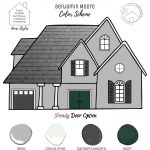Discover The Ultimate Guide To House Paint Types: Enhance Your Home With The Perfect Palette!
House Paint Types: A Comprehensive Guide for Home Lovers
Greetings, Home Lovers! Whether you’re a seasoned homeowner or a first-time buyer, choosing the right type of paint for your house can be a daunting task. With an overwhelming number of options available in the market, it’s crucial to understand the different house paint types and their benefits. In this article, we will explore the various types of house paints, their characteristics, and their suitability for different surfaces. So, let’s dive in and discover the world of house paint!
Introduction
Painting your house not only enhances its appearance but also protects it from weather elements and wear and tear. However, selecting the right type of paint is essential to ensure long-lasting and satisfactory results. To make an informed decision, it’s crucial to understand the different house paint types available in the market today. In this guide, we will explore each type in detail, providing you with the knowledge to choose the perfect paint for your home.
1 Picture Gallery: Discover The Ultimate Guide To House Paint Types: Enhance Your Home With The Perfect Palette!

1. Latex Paints 🎨

Image Source: houselogic.com
Latex paints, also known as water-based paints, are the most popular choice among homeowners and professionals alike. These paints are easy to apply, have a quick drying time, and offer excellent durability. They are also low in toxic fumes, making them a safer option for indoor use. Latex paints work well on various surfaces, including walls, ceilings, and wood.
2. Oil-Based Paints 🎨
Oil-based paints, also called alkyd paints, have been around for decades and are valued for their durability and smooth finish. These paints are ideal for high-traffic areas and surfaces that require superior protection. However, they have a longer drying time and emit strong odors, requiring proper ventilation during application. Oil-based paints are commonly used on trim, doors, and furniture.
3. Acrylic Paints 🎨
Acrylic paints are a versatile option that offers a balance between latex and oil-based paints. They are known for their excellent adhesion, flexibility, and resistance to cracking. Acrylic paints dry quickly and have minimal odor. They are suitable for both interior and exterior surfaces, including walls, wood, and metal.
4. Enamel Paints 🎨
Enamel paints are oil-based paints that provide a hard, glossy finish. They are highly durable, resistant to stains, and easy to clean, making them ideal for surfaces prone to heavy use or exposure to moisture. Enamel paints are commonly used on doors, cabinets, and furniture.
5. Textured Paints 🎨
If you’re looking to add depth and character to your walls, textured paints are an excellent choice. These paints contain added granules or particles that create a textured effect, adding visual interest to your space. Textured paints work well on both interior and exterior surfaces and can be used to hide imperfections.
6. Chalk Paints 🎨
Chalk paints have gained popularity in recent years due to their unique matte finish and ease of use. These paints require minimal prep work, as they adhere well to various surfaces without the need for priming or sanding. Chalk paints are often used for furniture and decorative pieces, creating a vintage or rustic look.
What Are House Paint Types?
House paint types refer to the different categories of paints available for use on residential surfaces. Each type has its unique composition, characteristics, and suitability for specific applications. Understanding the various house paint types will help you make an informed decision when it comes to painting your home.
Who Should Use House Paint Types?
House paint types are suitable for homeowners, tenants, and professionals involved in residential painting projects. Whether you’re planning to paint your entire house or just a single room, having knowledge about different paint types will help you achieve the desired results.
When to Use House Paint Types?
Knowing when to use different house paint types is crucial for achieving optimal results. Factors such as the surface to be painted, the location of the surface (interior or exterior), and the desired finish play a significant role in determining the appropriate paint type to use.
Where to Use House Paint Types?
House paint types can be used on various surfaces, including walls, ceilings, doors, trim, furniture, and more. The specific type of paint you choose will depend on the surface you’re painting and the desired outcome.
Why Choose House Paint Types?
The choice of house paint types affects the overall appearance, durability, and longevity of your painted surfaces. By selecting the right paint type for each specific application, you can achieve professional-looking results and protect your home from damage and deterioration.
How to Choose House Paint Types?
Choosing the right house paint type requires considering factors such as surface preparation, desired finish, level of durability, and personal preferences. It’s essential to assess the specific requirements of your project and consult with paint professionals if needed.
Advantages and Disadvantages of House Paint Types
1. Latex Paints 🎨
Advantages: Latex paints offer easy application, quick drying time, low odor, and durability. They are also available in a wide range of colors and finishes.
Disadvantages: Latex paints are not as durable as oil-based paints and may not provide the same level of protection on high-traffic surfaces.
2. Oil-Based Paints 🎨
Advantages: Oil-based paints provide superior protection, durability, and a smooth finish. They are excellent for high-traffic areas and surfaces exposed to moisture.
Disadvantages: Oil-based paints have a longer drying time, emit strong odors, and require proper ventilation during application. They also tend to yellow over time.
3. Acrylic Paints 🎨
Advantages: Acrylic paints offer excellent adhesion, flexibility, and resistance to cracking. They dry quickly, have minimal odor, and are suitable for various surfaces.
Disadvantages: Acrylic paints may not provide the same level of durability as oil-based paints and can be more expensive.
4. Enamel Paints 🎨
Advantages: Enamel paints provide a hard, glossy finish that is highly durable. They are resistant to stains and easy to clean.
Disadvantages: Enamel paints are oil-based, emit strong odors, and require proper ventilation. They also tend to be more expensive than other paint types.
5. Textured Paints 🎨
Advantages: Textured paints add depth and character to your walls, hiding imperfections. They are suitable for both interior and exterior surfaces.
Disadvantages: Textured paints may require more effort during application and can be challenging to remove or change.
Frequently Asked Questions (FAQs)
1. Can I apply latex paint over oil-based paint?
Answer: Yes, but proper surface preparation, such as sanding and priming, is necessary for optimal adhesion.
2. How long does it take for paint to dry completely?
Answer: Drying times vary depending on the paint type and environmental conditions. Generally, it takes a few hours to several days for paint to dry completely.
3. Can I use exterior paint indoors?
Answer: While it is possible to use exterior paint indoors, it may have a higher concentration of volatile organic compounds (VOCs), which can be harmful when inhaled. It’s advisable to use paint specifically formulated for interior use.
4. Can I mix different types of paint?
Answer: Mixing different types of paint is not recommended, as it can lead to compatibility issues and affect the paint’s performance.
5. How often should I repaint my house?
Answer: The frequency of repainting depends on various factors, such as the quality of the paint, environmental conditions, and the level of wear and tear. On average, houses should be repainted every 5-10 years.
Conclusion
In conclusion, selecting the right type of paint is crucial for achieving optimal results when painting your house. Understanding the characteristics, advantages, and disadvantages of different house paint types will help you make an informed decision. Consider factors such as surface type, location, desired finish, and durability when choosing the perfect paint for your home. Remember to follow proper preparation and application techniques for the best outcome. Happy painting, and may your home be filled with beauty and vibrant colors!
Final Remarks
Painting your house can be a rewarding experience that transforms your living space. However, it’s important to note that proper surface preparation, application techniques, and safety precautions are essential for successful results. Always read and follow the manufacturer’s instructions when using any type of paint. If you’re uncertain or inexperienced, consider hiring a professional painter to ensure a high-quality finish. Happy painting, and may your home be a reflection of your personal style and warmth!
This post topic: Paint



